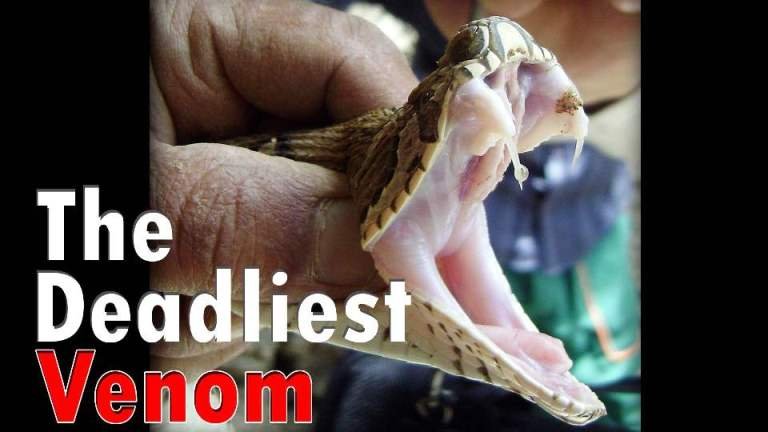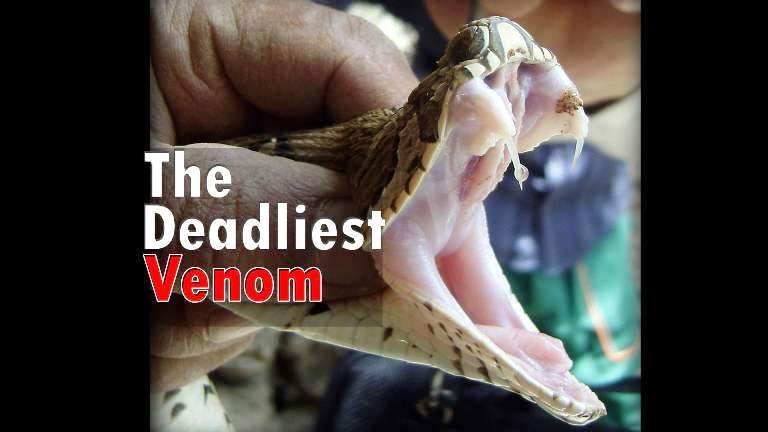The Deadliest Venom
Explore the fascinating and dangerous world of venomous snakes in our latest article, “The Deadliest Venom.” Delve into the science behind snake venom, its types, and the most lethal species on the planet. Learn about neurotoxic, hemotoxic, and cytotoxic venoms, and discover which snakes possess the most potent toxins. With approximately 600 venomous snake species worldwide, understanding these creatures is crucial for safety and survival. Gain vital knowledge on first aid measures to take if bitten by a venomous snake, and how to stay safe in snake-prone areas.

1. What is Venom?
Venom is a toxic substance produced by certain animals, including snakes, spiders, scorpions, and some marine creatures. In snakes, venom is a complex mixture of proteins and enzymes designed to immobilize, kill prey, and aid in digestion. It is delivered through specialized teeth (fangs) during a bite. Venom can cause various effects on the victim, including pain, paralysis, tissue damage, and even death.
2. Types of Venom
Snake venoms are primarily categorized into three types based on their effects on the victim’s body:
| Type of Venom | Effect | Symptoms | Example |
|---|---|---|---|
| Neurotoxic Venom | Targets the nervous system | Paralysis, respiratory failure, muscle weakness | Cobras, kraits, and mambas |
| Hemotoxic Venom | Affects the circulatory system and blood cells | Hemorrhaging, blood clotting issues, tissue damage | Vipers and pit vipers (e.g., rattlesnakes) |
| Cytotoxic Venom | Destroys cells and tissues | Severe pain, swelling, tissue necrosis | Some species of vipers and adders |
3. Most Dangerous Venom in the World
While many snakes have potent venom, a few stand out due to their extreme toxicity and potential to cause fatal bites:
a. Inland Taipan (Fierce Snake)
- Location: Australia
- Venom: Extremely neurotoxic, capable of killing an adult human in under an hour.
- Bite Fatality: Rare, due to the snake’s reclusive nature.
b. Belcher’s Sea Snake
- Location: Indian and Pacific Oceans
- Venom: Highly potent neurotoxin, believed to be the most toxic of all snakes.
- Bite Fatality: Low, as it is generally not aggressive towards humans.
c. King Cobra
- Location: Southeast Asia
- Venom: Neurotoxic and cytotoxic.
- Bite Fatality: High, due to the large quantity of venom delivered.
4. How Many Venomous Snakes in the World?
There are approximately 600 venomous snake species in the world, which is about one-third of the roughly 3,000 known snake species. Venomous snakes are found on every continent except Antarctica, with a significant presence in tropical and subtropical regions.
5. How Can We Save a Life if Bitten by a Venomous Snake?
a. Stay Calm and Call for Help
- Action: Try to remain calm and call emergency services immediately. Panic can increase the spread of venom through the bloodstream.
b. Immobilize the Affected Limb
- Action: Keep the bitten limb below heart level and as still as possible to slow venom circulation.
c. Remove Constrictive Items
- Action: Remove rings, bracelets, or tight clothing from the affected area, as swelling is likely to occur.
d. Do Not Suck the Venom
- Myth Busting: Avoid cutting the wound or attempting to suck out the venom.
e. Apply a Pressure Immobilization Bandage (For Neurotoxic Bites)
- Action: For bites from neurotoxic snakes, apply a firm bandage over the bite site and along the limb. This can slow venom spread.
f. Monitor Vital Signs
- Action: Monitor the victim’s breathing and heart rate closely. Be ready to administer CPR if it becomes necessary.
g. Seek Antivenom Treatment
- Action: Antivenom is the most effective treatment for venomous snake bites. Administered in a medical facility, it can neutralize the venom and prevent severe symptoms.
Fascinating Facts About Snake Venom
- Venom Variation by Diet and Environment:
- Snake venom composition can vary significantly depending on the snake’s diet and environment. For instance, the venom of a snake that primarily eats birds will differ from one that preys on mammals.
- Venom as a Medical Tool:
- Researchers are exploring snake venom for medical uses. Components of venom have been used to develop drugs for conditions like high blood pressure, heart attacks, and even certain cancers.
- Venom Evolution:
- Venom is an evolutionary adaptation that has developed over millions of years. Some snakes have evolved highly specialized venoms tailored to their specific prey, making them incredibly efficient hunters.
- Venom Yield:
- The amount of venom a snake can produce and inject varies widely among species. The Gaboon viper, for example, has the longest fangs of any snake and can deliver one of the largest venom doses in a single bite.
- Venom and the Immune System:
- Some animals have developed immunity to certain snake venoms. For example, the mongoose is resistant to cobra venom, allowing it to prey on these snakes.
- Venom Harvesting:
- Venom extraction, or “milking,” is a process where venom is harvested from snakes for research and antivenom production. This is done by allowing the snake to bite into a container, releasing its venom.
- Self-Defense Mechanism:
- While venom is primarily used for hunting, snakes also use it for self-defense. The bite of a defensive snake can be just as potent as one meant for prey.
- Venom Gland Location:
- Venom glands are located behind the eyes in most venomous snakes. These glands are connected to hollow fangs that deliver the venom during a bite.
- Dry Bites:
- Not every venomous snake bite results in venom injection. Snakes can control whether or not they inject venom, and sometimes they deliver a “dry bite” as a warning.
- Venom and Snake Age:
- The potency and composition of venom can change as a snake matures. Juvenile snakes often have more potent venom relative to their size compared to adults, making their bites particularly dangerous.
- Venom Detection:
- Scientists can use advanced techniques to analyze venom composition, leading to better understanding and treatment of snake bites. This research is crucial for developing more effective antivenoms.
- Cultural Significance:
- Throughout history, snake venom has held a place in various cultures, often symbolizing both danger and healing. In some traditions, it’s believed to have mystical properties.
Related Articles
| Title | Link |
|---|---|
| Most Dangerous Snakes in the World | Most Dangerous Snakes in the World |
| The Ultimate Guide to Snakes: Venomous, Semi-Venomous, and Non-Venomous | The Ultimate Guide to Snakes: Venomous, Semi-Venomous, and Non-Venomous |
| History of Snakes: Evolution, Habitats, and Survival | History of Snakes: Evolution, Habitats, and Survival |
Snake Bite Management
Frequently Asked Questions (FAQ)
1. What exactly is snake venom?
Snake venom is a blend of proteins, enzymes, and various toxins. These substances work together to paralyze and digest prey, as well as to protect the snake from threats.
2. How do snakes inject their venom?
Snakes deliver venom through specialized fangs. When a snake bites, muscles around the venom glands squeeze, pushing the venom through ducts and into the fangs, which then inject it into their target.
3. What’s the difference between venomous and poisonous snakes?
Venomous snakes actively inject venom through their bites, while poisonous snakes are harmful if ingested or touched. Venomous refers to the mode of delivery, and poisonous refers to the nature of the toxin.
4. Can snakes control how much venom they inject?
Yes, many snakes can regulate the amount of venom they inject. They might deliver a full dose or a “dry bite” with no venom, often as a warning rather than a lethal attack.
5. What should you do right after a venomous snake bite?
Stay calm and call for emergency assistance right away. Keep the bitten limb elevated and immobile. Remove any constricting items like tight clothing or jewelry near the bite. Do not attempt to cut the wound or extract the venom. For bites from neurotoxic snakes, apply a pressure bandage and seek medical help as soon as possible.
6. How is antivenom produced?
Antivenom is created by injecting small, controlled amounts of venom into animals like horses or sheep. These animals produce antibodies, which are then collected, purified, and used to make the antivenom.
7. Are there animals that are immune to snake venom?
Yes, some animals, like mongooses and certain snake species, have developed natural resistance to specific types of snake venom, allowing them to survive bites that would be fatal to other creatures.
8. Can snake venom be used for medical purposes?
Absolutely! Researchers are studying snake venom to develop treatments for various health issues, including high blood pressure, heart attacks, and blood clotting disorders. Some venom components have shown promising medical benefits.
9. How many venomous snake species are there globally?
There are about 600 venomous snake species worldwide, which constitutes roughly one-third of all known snake species. They inhabit every continent except Antarctica.
10. What is a “dry bite”?
A “dry bite” occurs when a venomous snake bites but doesn’t inject any venom. This is often a defensive bite and can occur in up to half of all venomous snake bites.
11. Why do some snakes have more potent venom than others?
Venom potency varies depending on factors like the snake’s diet, habitat, and evolutionary adaptations. Some snakes have evolved particularly strong venom to effectively immobilize their preferred prey.
12. What actions should be avoided after a snake bite?
Avoid cutting the wound, attempting to suck out the venom, applying ice, or using a tourniquet. These methods can be harmful and don’t help with treating the bite. Seek professional medical help immediately.
13. Can snake venom be deadly to humans?
Yes, snake venom can be fatal if not treated quickly. The danger depends on the snake species, the amount of venom injected, and how fast medical treatment is received.
14. Do all venomous snakes have the same type of venom?
No, venom types differ among snakes. Venom can be neurotoxic, hemotoxic, or cytotoxic, affecting the body in various ways. Each snake’s venom is adapted to its specific prey and survival needs.
15. How can you identify a venomous snake?
Identifying a venomous snake can be challenging and varies by region. Common signs include triangular heads, slit-like pupils, and distinctive color patterns. It’s best to avoid handling any snake unless you’re a trained expert.



